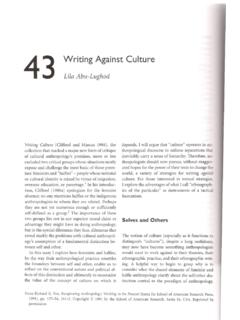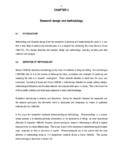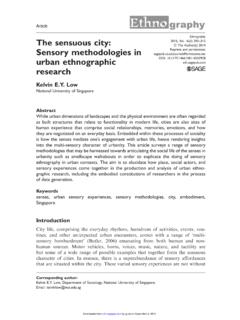Transcription of THEORIES OF CULTURE - kodu.ut.ee
1 Copyright 1974. 4 ll rights reserved THEORIES OF CULTURE . Roger M. Keesing^. Institute of Advanced Studies, Australian Nationai Universily Cdoberra , Australia INTRODUCTION. "Yanomamo CULTURE ," "Japanese CULTURE ," "the evolution of CULTURE ," "nature vs CULTURE "; we anthropologists are still using that word, and we stili think it means something. But looking across at our primate relatives learning local traditions, using tools, and manipulating symbols, we can no longer say comfortably that " CULTURE " is the heritage of learned symbolic behavior that makes humans human. And standing amid the swirling tides of change and individual diversity, we can no longer say comfortably that "a cuiture" is the heritage people in a particular society share.
2 Moreover, we increasingly realize that the holistic, humanistic view of CULTURE synthesized by Kroeber and Kluckhohn includes too much and is too diffuse either to separate analytically the twisted threads of human experience or to interpret the designs into which they are woven. The challenge in recent years has been to narrow the concept of " CULTURE " so that it includes less and reveals more. As Geertz argues, "cutting the CULTURE concept down to size .. [into] a narrowed, specialized, and .. theoretically more powerful concept" (30, p. 4) has been a major theme in modem anthropological theorizing.
3 ^ And predictably, modem anthropologists have not agreed on the best way to narrow and sharpen the central conceptual tool they have inherited from tiieir elders. In the pages that follow, I wili summarize recent rethinkings of " CULTURE " as ' I am indebted to the Center for Advanced Study in the Behavioral Sciences, Stanford, California, for providing an idyllic setling where this review could be written, and to Bridget O'Laughlin. Mervyn Meggitt. Triloki Nath Pandev. and Gregory Bateson for their helpful suggestions. ^ Implicit in this view is an assumption .shared by most of us, I think: that " CULTURE " does not liave some true and sacred and eternal meaning we are trying to discover; but that like other symbols, it means whatever we use it to mean; and that as with other analytical concepts, human users must carve out and try to partly agree on a of natural phenomena it can most strategically label.
4 73. 74 KEESING. falling into four focal areas. Having highlighted work being done in each area,^ I. will seek to clarify the terminological, philosophical, and substantive issues that divide major theorists. In the process, I will consider the impUcatiom of these rethinkings for a number of classic anthropological questions: How have cultures developed and what forces shape them? How are cultures learned? How do shared symbolic systems transcend individual thought worlds? How different and unique are cultures? Do universal patterns underlie diversity? How is cultural description to be possible? CULTURES AS ADAPTIVE SYSTEMS.
5 An important expansion of cultural theory has come from viewing cultures in evolutionary perspective. A widened bridge between studies of hominid evolution and studies of human social Ufe has led us to see more clearly that the human biological design is open-ended, and to perceive the way its completion and modification through cultural learning make human life viable in particular ecological settings. Applying an evolutionary model of natural selection to cultural constructions on biological foundations has led anthropologists to ask with increasing sophistication how human communities develop particular cultural patterns.
6 A vast literature, popular and technical, has dealt with the interweaving and relative importance of biological and cultural components of human behavior. Aggression, territoriality, sex roles, facial expression, sexuality, and other domains where cultural and biological are interwoven have been endlessly and often mindlessly discussed. From all this, we shall draw two brief conclusions, then pass on. First, any notion that if we peel off the layers of cultural convention we will ultimately find Primal Man and naked human nature underneath is both sterile and dangerous; we need a complex interactional model, not a simplistically stratigraphic one (19, 25).
7 Second, either extreme ethological or extreme cultural determinism can now be sustained by ideology and faith but not by sober science. Just how biological templates are transformed and elaborated into cultural pat- tems will have to be worked out for each realm; and that will take careful and imaginative research designs and patient exploration, not polemics and sensa- tionalism. How human cultures are distinctive, despite the continuities in hominid evolu- tion, has been extensively reviewed by HoUoway (45), Alland (2,3), Montagu (59), and others. A crucial issue here is how and at what stage vocal language evolved and what its immediate precursors were (44).
8 If the evidence that an elaborated vocal language is less than 100,000 years old holds up, a vast period looms when ' 1 will not list exhaustively the publications where " CULTURE " is used or cultural theory is applied or developed. Since that would include a substantial proportion of the writings in anthropology, this would not only be impossible, but trivial and unrevealing: a focus on high points and highlights is clearly demanded in a review article concerned with refinement of theory, not accumulation of substance. THEORIES OF CULTURE 15. eariy humans lived in bands, made tools, hunted in well-planned forays, probably lived in pair-bond family relationships a period of two million years or more of proto-human social life without a fully elaborated code for symbolic com- munication.
9 Our understanding of what makes humans human and how cultures evolved will doubtless unfold and ehange excitingly in the next few years. From the standpoint of cultural theory, however, the major developments have eame from evolutionary/ecological approaches to eultures as adaptive systems. The major spawning grounds of evolutionary/eeologieal rethinkings have been Michigan and Columbia. The foundations laid by Leslie White have been crea- tively recast by sueh scholars as Sahlins, Rappaport, Vayda, Harris, Carneiro; and by such theory-minded areheologists as the Binfords, Flannery. Longacre, Sanders, Priee, and Meggers.
10 The rapproehement ofa theoretical areheology with ecological anthropology emerges as one ofthe major developments ofthe past decade. Thai is not to imply that prevails about how cultures are best con- ceptualized or how and why they develop and change. The recent exchanges between Service (75) and Harris (42), Marxist critiques of Harris' cultural materialism, the gulfs between cultural ecology and the human eeology conceived by Vayda & Rappaport (81), the seetarian wars within "the new archeology," all attest to diversity and disagreement. Given this sectarian diversity, most scholars working in this tradition (I will fbr shorthand call them "cultural adaptationists")''.








